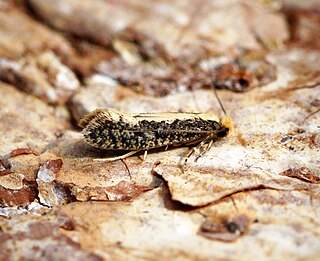Related Research Articles

Tineidae is a family of moths in the order Lepidoptera described by Pierre André Latreille in 1810. Collectively, they are known as fungus moths or tineid moths. The family contains considerably more than 3,000 species in more than 300 genera. Most of the tineid moths are small or medium-sized, with wings held roofwise over the body when at rest. They are particularly common in the Palaearctic, but many occur elsewhere, and some are found very widely as introduced species.

Tineoidea is the ditrysian superfamily of moths that includes clothes moths, bagworms and relatives. There are six families usually included within it, Eriocottidae, Arrhenophanidae, Lypusidae, Acrolophidae, Tineidae and Psychidae, whose relationships are currently uncertain.

Tinea pellionella, the case-bearing clothes moth, is a species of tineoid moth in the family Tineidae, the fungus moths. This species has a cosmopolitan distribution, occurring nearly worldwide.

Agnathosia is a genus of moths belonging to the family Tineidae.
Eudarcia is a genus of moths belonging to the family Tineidae.

Infurcitinea is a genus of the fungus moth family, Tineidae. Therein, it belongs to the Meessiinae, one of the larger fungus moth subfamilies.
Myrmecozela is a genus of moths belonging to the family Tineidae erected by Philipp Christoph Zeller.
Rhodobates is a genus of moths belonging to the family Tineidae. The genus was first described by Ragonot in 1895.

Ateliotum is a small genus of the fungus moth family, Tineidae. It belongs to the subfamily Myrmecozelinae.

Edosa is a genus of moths belonging to the family Tineidae.

Anomalotinea is a genus of moths belonging to the family Tineidae.
Reisserita is a genus of moths belonging to the family Tineidae.

Tinea is a genus of the fungus moth family, Tineidae. Therein, it belongs to the subfamily Tineinae. As evident by its name, it is the type genus of its subfamily and family. Established as one of the first subgroups of "Phalaena", it used to contain many species of Tineidae that are nowadays placed in other genera, as well as a few moths nowadays placed elsewhere.
Phereoeca allutella, the household case-bearing moth, belongs to the subfamily Tineinae of the fungus moth family (Tineidae). It was first described by Hans Rebel in 1892. It is an occasional pest of furs, flannel and similar materials, and has been inadvertently introduced to many places it is not originally native to.

Monopis crocicapitella, the pale-backed clothes moth, is a moth of the family Tineidae described by James Brackenridge Clemens in 1859. It has a nearly cosmopolitan distribution. It was first described from the eastern United States. It is particularly destructive of fabric and clothes.

Karsholtia is a genus of moths of the family Tineidae. The genus contains the single species Karsholtia marianii. It is found in Norway, Sweden, Denmark, Germany, Austria, France and on Sicily.
Rhodobates nodicornella is a moth of the family Tineidae first described by Hans Rebel in 1911. It is found in Lebanon and Jordan.

Epermenia is a genus of moths in the family Epermeniidae. The genus was first described by Jacob Hübner in 1825.

Anomalotinea cubiculella is a moth in the family Tineidae. It was described by Staudinger in 1859. It is found in Spain, Palestine, Algeria, Libya and Mauritania.